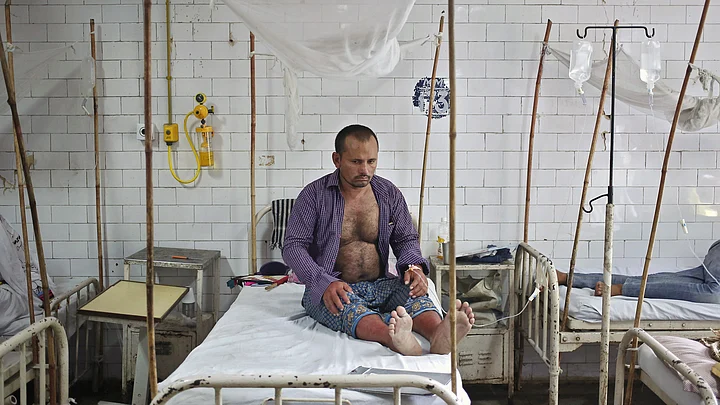The recent attack by relatives of a dengue patient on doctors and damage to hospital infrastructure in Mumbai – following which over 4,500 doctors in Maharashtra went on a strike demanding adequate security and protection – has once again raised the question of why India cannot expand its medical education and treatment sector. India has a skewed doctor-patient ratio of nearly 1: 11,000, as revealed by the recent National Health Profile 2015 report prepared by the Central Bureau for Health Intelligence (CBHI).
Doctors believe a simultaneous approach towards increasing the number of medical colleges, medical seats and hospital infrastructure – including training of nurses and other staff – is needed to reduce the burden on hospitals, and to bring down the cost of treatment as well.
Inaccessible Healthcare
- India has a skewed doctor-patient ratio of nearly 1: 11,000.
- There is only one allopathic doctor for every 11,000 people and only one government hospital bed for every 1,833 people.
- India has 9.4 lakh registered allopathic doctors, 1.54 lakh dental surgeons, and 7.37 lakh AYUSH doctors.
- India needs to significantly increase its spending on health from the present 1 per cent.
Abysmal Infrastructure
India’s medical infrastructure has not been able to keep pace with the increase in population.
According to the National Health Profile Report 2015 – released this past week, there is only one allopathic doctor for every 11,000 people and only one government hospital bed for every 1833 people. Worse still, the current medical education system is way behind the requirement. In the nearly 22 years between 1991-92 and 2013-14, only 252 medical colleges have been added, taking the total number to 398. And their cumulative intake is 46,456 students.
As per CBHI, India now has 9.4 lakh registered allopathic doctors, 1.54 lakh dental surgeons, and 7.37 lakh AYUSH doctors. Clearly the numbers are not sufficient for the nearly 1.27 billion population.
Much of the increase in the number of allopathic doctors has taken place since 2007 as nearly 2 lakh allopathic doctors were registered with Medical Council of India and state medical councils between then and 2014.
The pace has been rather slow considering crores of people in the country do not have access to medical facilities. Though medical colleges have been opened in the private sector, allegations of corruption in admission and sale of seats has presented a scary scenario.
Why a Dearth of Private Colleges?
India needs to significantly increase its spending on health from around 1 per cent at present. Simultaneously, the licensing regime for opening private medical colleges should be liberalised and such colleges should be attached to all major private hospitals.
The counter argument would be that it would lead to a drastic fall in the standard of medical education. However, as a senior doctor pointed out, already a large number of Indian doctors who completed their MBBS from China, Nepal, Ukraine and Russia are knocking at the doors of the National Board of Examinations (NBE), that screens them through a computer-based Foreign Medical Graduate Examination, before allowing them the right to practice in India.
With 11,825 students from China, 5,950 from Russia and 3,163 from Nepal applying to NBE between 2012 and 2014, the question remains if students coming from private medical colleges abroad can be eligible for practice in India, then why can more private colleges not be opened in the country itself.
Problem of Growing Commercialism
As far as the issue of corruption goes, two Delhi University teachers, Anish Gupta and Aaleya Giri, had in a recent paper on “Apathetic Hospitals: Moneymakers have no value for Have-Nots’’, noted that recent instance of refusal of treatment to poor patients in the National Capital have only “exposed the growing commercialism and disintegrating ethics in the world of healthcare.”
Holding the problem of corruption in healthcare to be “multi-dimensional”, they said, “often public assets and instruments in Government hospitals are deliberately damaged so as to make them unavailable to patients, with the ulterior motive referring to the services of private clinics in return for financial incentives or `commission’.”
They also noted that Government hospitals not only bear the burden of treating the poor, but are also dealing with complicated and critical cases where chances of survival are too bleak.
As for the private hospitals, they averred that corruption was of a “different nature”. “Generally in private hospitals, physicians have contractual obligations to admit a fixed number of patients to allotted beds and prescribe a number of laboratory investigations, even if unnecessary, to generate revenues.”
With the situation leading to financial, physical and emotional distress among patients and their relatives, attacks on hospitals and doctors are becoming commonplace. An urgent way out is needed to prevent further damage to the medical infrastructure—and it can only come by way of opening the sector so that the demand-supply mismatch is taken care of.
On Sunday, a member of the Niti Aayog and recipient of the Padma Bhushan, Dr Saraswat, provided a glimmer of hope while speaking at a convocation function in Lucknow when he said the Government funding in health sector was set to go up from existing 1.2 per cent to 2.5 per cent of the gross domestic product.
The funds would primarily be spent on disease prevention and research so that root cause of disease is identified.
—Dr Saraswat, Member, Niti Aayog
(The writer is a freelance journalist.)
